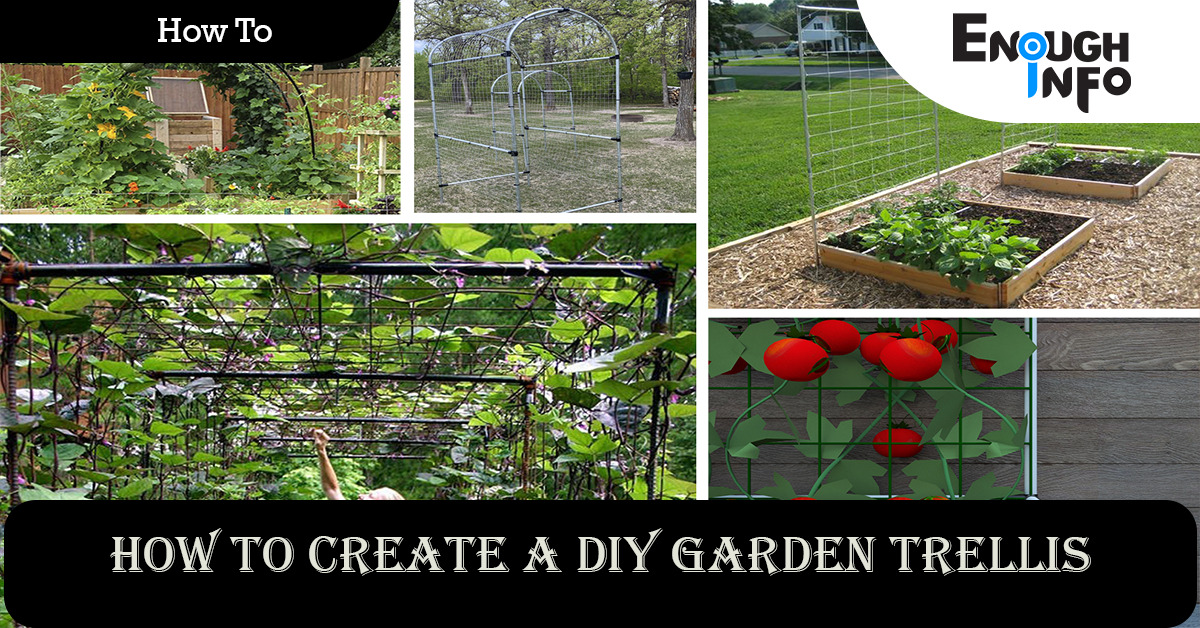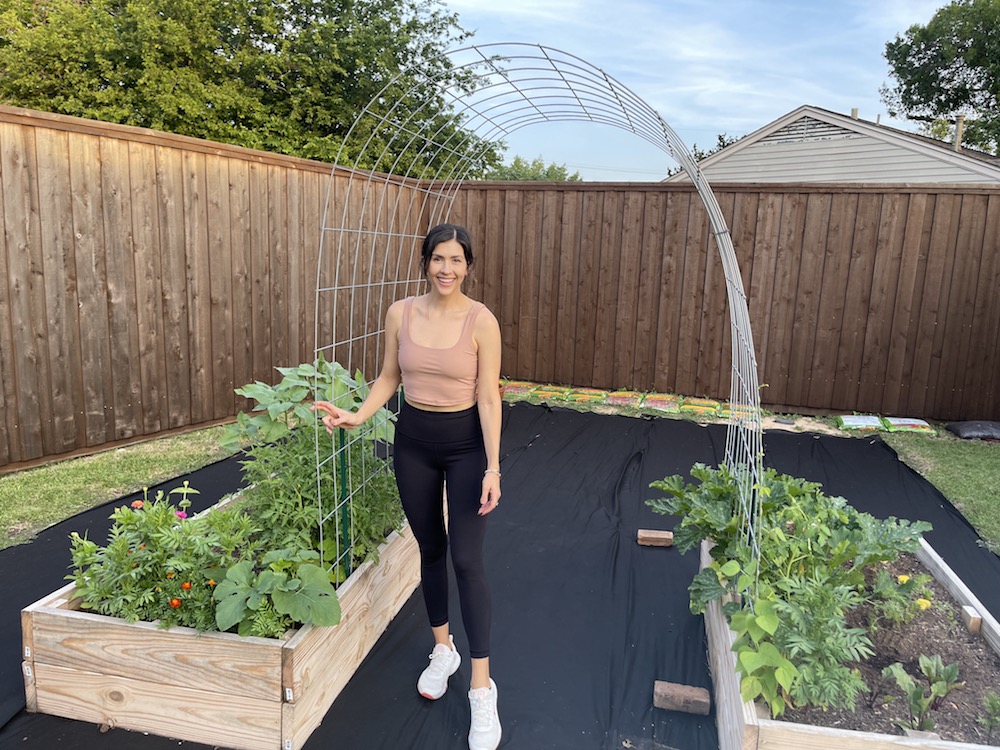How to create a DIY garden trellis

How to create a DIY garden trellis – A garden trellis is a versatile and practical addition to any garden. Not only does it provide support for climbing plants, but it also adds visual interest and structure to your outdoor space. Building a DIY garden trellis is a rewarding and cost-effective project that allows you to customize the design according to your preferences and garden size. EnoughInfo.com
There is a sense of accomplishment and pride that comes with creating something with your own hands. Building a DIY garden trellis allows you to take an active role in your garden’s development and adds a personal touch to your outdoor space. The satisfaction of seeing your plants thrive on a trellis you built yourself is immensely rewarding.

Creating a DIY garden trellis is important because it provides support for climbing plants, optimizes space, enhances aesthetics, allows customization, is cost-effective, promotes sustainability, fosters gardening education, ensures gardening success, offers longevity and reusability, and provides personal satisfaction. So why not embark on this fulfilling journey and enjoy the numerous benefits that a DIY garden trellis brings to your garden and overall gardening experience? How To Make Homemade Bath Bombs
Read Also: How to start a vegetable garden
Building a DIY Garden Trellis: A Step-by-Step Guide to Enhance Your Garden Space
In this comprehensive guide, we will take you through the step-by-step process of creating your own garden trellis, along with answers to frequently asked questions to help you get started.
Planning and Design
-
Assessing Your Garden:
- Evaluate your garden space to determine the suitable location for the trellis. Consider factors such as sunlight exposure, plant types, and available vertical surfaces.
-
Choosing the Trellis Design:
- Explore different trellis designs, such as a ladder, grid, arched, or fan-shaped trellises. Select a design that complements your garden aesthetic and accommodates the growth of your chosen plants.
-
Selecting Materials:
- Choose the appropriate materials for your trellis, such as wood, bamboo, metal, or PVC. Consider durability, aesthetic appeal, and ease of maintenance.
Gathering Materials and Tools
-
Materials Needed:
- List the specific materials required based on your chosen design, including lumber, screws, brackets, wire, or other decorative elements.
-
Tools Required:
- Prepare a set of essential tools like a saw, drill, measuring tape, level, screwdriver, and protective gear (gloves, safety glasses). How To Create A Meal Plan For Weight Loss
Building the Trellis
-
Measuring and Cutting:
- Measure and mark the dimensions for your trellis components on the selected materials. Use a saw to cut the pieces to the desired lengths.
-
Assembling the Frame:
- Follow the design plan to assemble the frame of your trellis using screws, brackets, or joinery techniques. Ensure the structure is sturdy and secure.
-
Attaching Cross Supports:
- Install cross supports horizontally or diagonally across the frame to provide additional strength and support for the climbing plants.
-
Adding Decorative Elements:
- Incorporate decorative elements like finials, lattice panels, or ornamental accents to enhance the visual appeal of your trellis. Secure them using appropriate fasteners.
Installing and Maintaining the Trellis
- Preparing the Ground:
- Choose the trellis location and clear the area of any obstacles or vegetation. Dig holes or install anchors to secure the trellis in the ground.
-
Mounting the Trellis:
- Position the trellis against a wall, fence, or freestanding in the ground. Use screws, brackets, or other suitable methods to secure it firmly.
-
Training Climbing Plants:
- Introduce climbing plants to the trellis by gently tying their stems to the structure with soft twine or plant ties. Guide the plants as they grow to ensure they follow the intended path.
-
Maintenance Tips:
- Regularly inspect the trellis for any damage or signs of wear. Repair or replace any weakened or broken components promptly. Maintain the trellis by pruning plants, removing dead foliage, and cleaning the structure as needed. How To Make Homemade Bread(Step By Step)
Read Also: How To Grow Herbs Indoors
FAQs about DIY Garden Trellis:
What is the best material for a garden trellis?
The choice of material depends on personal preference and the desired aesthetic. Wood is popular for its natural look, while metal offers durability. Bamboo and PVC are also suitable options. Consider the durability, maintenance requirements, and compatibility with your garden’s style.
How tall should a garden trellis be?
The height of the trellis depends on the plants you intend to grow. Consider the maximum height that the plants can reach and provide enough space for them to climb. Typically, a trellis height of 6 to 8 feet is sufficient for most climbing plants. https://enoughinfo.com/how-to-create-a-diy-garden-trellis
Can I build a trellis without any woodworking experience?
Yes, building a garden trellis can be a beginner-friendly project. There are simple trellis designs that require minimal woodworking skills, such as using pre-cut lumber and basic assembly techniques. Additionally, online tutorials and step-by-step guides can provide guidance throughout the process.
How do I maintain a wooden trellis?
To maintain a wooden trellis, apply a protective finish such as varnish or outdoor paint to prevent moisture damage and prolong its lifespan. Regularly inspect for signs of rot or decay and replace any damaged parts. Consider staining or repainting the trellis every few years to maintain its appearance.
Can I reuse materials to build a trellis?
Yes, reusing materials is an eco-friendly and cost-effective approach. Old ladders, bamboo poles, or salvaged wood can be repurposed to create unique trellises. Ensure that the materials are in good condition and structurally sound before using them. How To Make Homemade Bread(Step By Step)
How far apart should I space the vertical slats on a trellis?
The spacing between the vertical slats depends on the size of the plants you plan to grow. Generally, a spacing of 6 to 8 inches between slats provides sufficient room for plants to weave through and climb. Adjust the spacing based on the specific needs of your plants.
Can a trellis be used for vegetable plants?
Yes, trellises are commonly used for supporting and training various vegetable plants, such as tomatoes, cucumbers, beans, and peas. The trellis helps keep the plants off the ground, maximizing space and improving air circulation around the foliage.
Can I install a trellis in a container garden or on a balcony?
Absolutely! Trellises can be adapted for container gardens and balconies. Choose a trellis design that fits the available space and use containers with proper drainage. Secure the trellis to the container or balcony railing to ensure stability. How To Paint A Landscape With Oil Paints
How do I choose the right location for my trellis?
Consider the sunlight exposure and wind patterns in your garden. Most climbing plants require ample sunlight, so choose a location that receives sufficient light throughout the day. Additionally, ensure the trellis is positioned where it won’t obstruct walkways or other garden features.
Can I attach a trellis to a brick or concrete wall?
Yes, it is possible to attach a trellis to a brick or concrete wall. Use appropriate anchors and screws designed for masonry surfaces. Ensure the trellis is securely attached, as the weight of climbing plants can put a strain on the structure.
Read Also: Health Benefits Of Pomegranates (Step By Step)
Conclusion:
Building a DIY garden trellis not only adds functionality to your garden but also allows you to unleash your creativity and customize the design according to your preferences. By following the step-by-step guide and considering the FAQs provided, you can embark on this fulfilling project with confidence. Remember to choose the right materials, plan the design carefully, and maintain the trellis regularly to ensure its longevity and support the growth of your climbing plants. How to Clean Stainless Steel Appliances
Enjoy the process of creating a beautiful and functional trellis that enhances your garden space for years to come. Whether you’re growing flowers, vegetables, or vines, a well-built trellis will provide the necessary support and create an eye-catching focal point in your garden.
So gather your materials, don your protective gear, and get ready to embark on this exciting DIY project. With a little time and effort, you’ll soon have a stunning garden trellis that will transform your outdoor space into a flourishing oasis.
Happy building and happy gardening!




